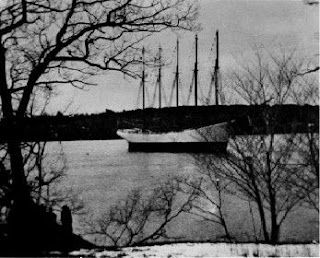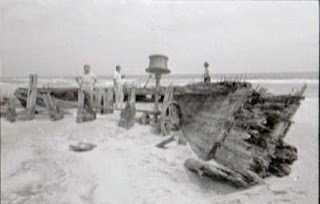98 years ago today, the Carroll A. Deering was shipwreck just off the shores of Hatteras and has been a mystery ever since.
Was it a mutiny, hurricane, pirates, or something else that caused this ship to run aground?
Check out this maritime history mystery and tell us what you think really happened to the Deering.
Ghost Ship Found Off Hatteras 96 Years Ago Today, Remains An Unsolved Mystery
By Jeff Hampton
The Virginian-Pilot
HATTERAS VILLAGE, N.C.
A five-masted schooner slammed into shoals off Hatteras 96 years ago today with sails fully engaged – and not one soul on board.
Only a healthy six-toed cat greeted the Coast Guardsmen sent to the rescue.
The Carroll A. Deering has been known ever since as the “ghost ship.”
“This is still one of the great unsolved maritime mysteries,” said Joe Schwarzer, director of the North Carolina Maritime Museums. “There are any number of potential explanations for it.”
At least five government agencies, including the Coast Guard and the FBI, investigated the wreck while family members and locals could only speculate about what happened.
The 225-foot Deering left Boston and picked up a load of coal in Norfolk in late 1920, bound for South America. The Deering company hired W.B. Wormell to replace Capt. William Merritt, who became too sick to make the voyage.
The Deering was on its return trip when it was sighted under sail Jan. 28, 1921, from the lightship at Cape Fear, south of Wilmington, Schwarzer said.
At 6:30 a.m. on Jan. 31, Coast Guard surfman Andrew Gray of Station 183 was on patrol when he spotted the schooner stranded on the outer edge of Diamond Shoals. Heavy waves prevented rescue boats from getting close enough to board.
“The schooner was driven high up on the shoals in a boiling bed of breakers,” according to an original report provided by the Outer Banks History Center.
The schooner’s lifeboats were gone and there was “no sign of life,” another report said.
Rescue crews returned four days later, after conditions improved.
They found food on the galley stove, clothing in lockers, three pairs of boots in the captain’s cabin, and a bed recently slept in, according to a 1921 Virginian-Pilot report.
Crews took ashore a gray six-toed cat found in good condition on board. It is believed the cat left a line of six-toed progeny on the Outer Banks, including one that lives today around the Hatteras ferry docks, historian Danny Couch said.
The crew may have abandoned the ship at sea and tried unsuccessfully to reach the shore in lifeboats. The U.S. Weather Bureau said a series of hurricanes in the Atlantic may have caused the Deering and other ships at the time to wreck or disappear. But the ghost ship lodged on the shoals in good shape.
A steamship in the area, the Hewitt, could have taken the crew aboard to save them from a storm, Schwarzer said. The Hewitt later sank with all its crew and possibly took down the Deering survivors with it.
Capt. Wormell’s widow and some shipping officials believed pirates raided the ship and killed the crew. The Bath, N.C., Daily Times reported in June 1921:
“Romantic and impossible as pirate theories appear to be in these modern days, the investigation conducted by the allied departments … seems to substantiate the belief that a torpedo boat chaser purchased from some foreign government … has been outfitted as a pirate craft and is preying upon vessels in the South Atlantic.”
Papers found at a Russian communist office in New York called for members to seize U.S ships. The Deering could have been one of the targets, according to reports of the day.
Three other ships disappeared around the same time, raising speculation that it was the work of pirates or Russians. Rum runners – illegal alcohol smugglers – also were suspected of taking the ship and “dashing off into the darkness.”
Or the men could have mutinied.
Wormell told a friend on Barbados during the voyage that he had no faith in his crew. The crew likely would have kept the ship and sailed away rather than beach her, a report said.
But searches along the Eastern Seaboard never turned up any bodies, boats or conclusive evidence.
Meanwhile, locals salvaged parts of the ship. The Coast Guard blew up the remains to eliminate it as a navigation hazard. Beams from the ship are exposed at times on an Ocracoke beach, Schwarzer said.
The Graveyard of the Atlantic Museum exhibits artifacts including the ship’s bell, a flask and a steam-powered windlass, or winch.
Still missing is an explanation.
“It’s such an alluring story because nobody was ever able to solve it,” Schwarzer said.


